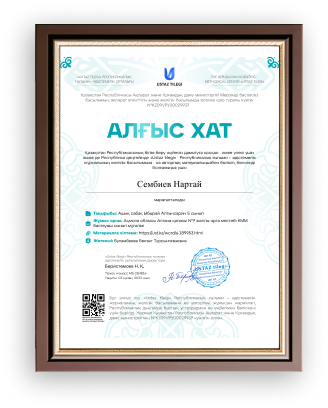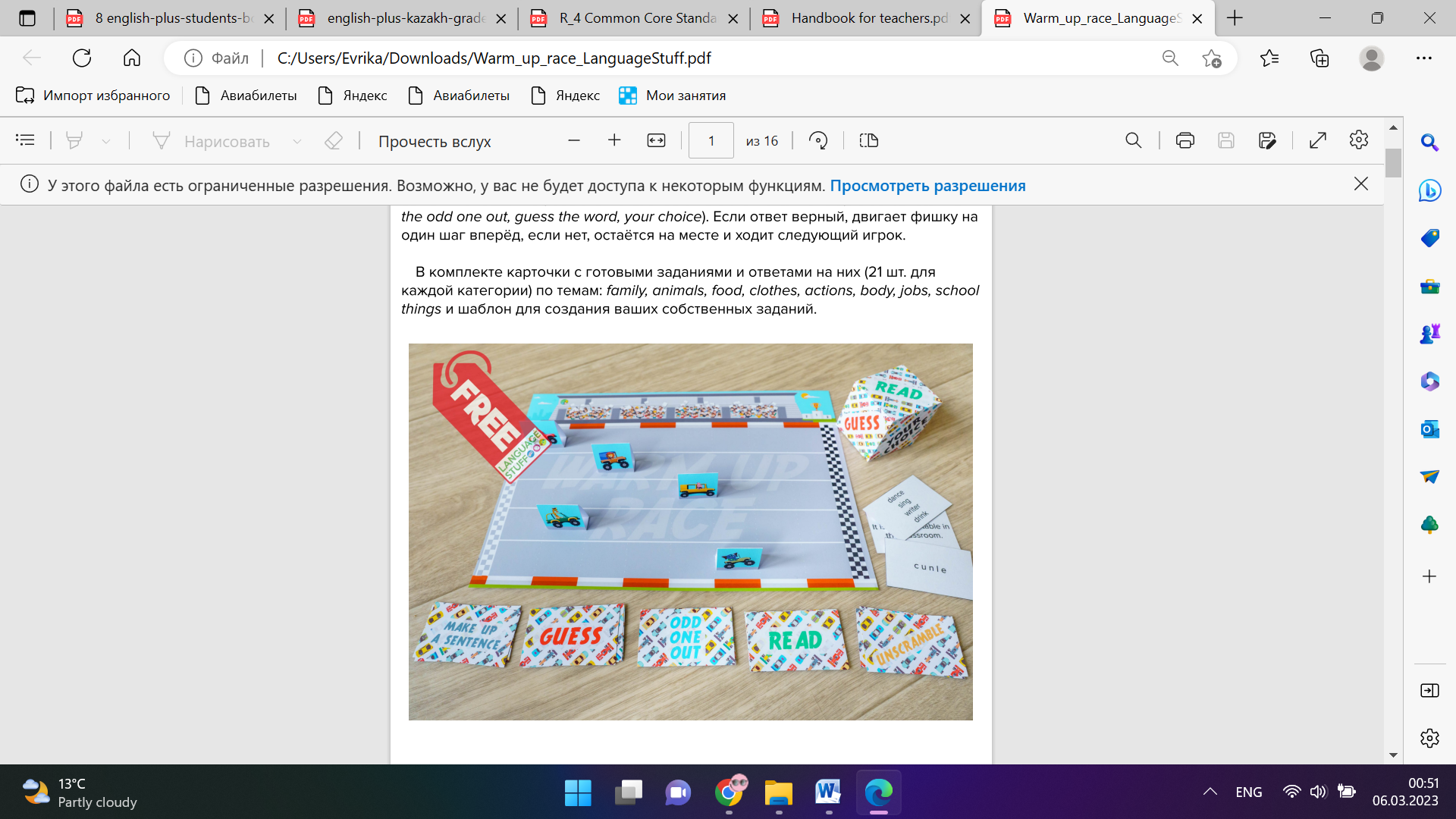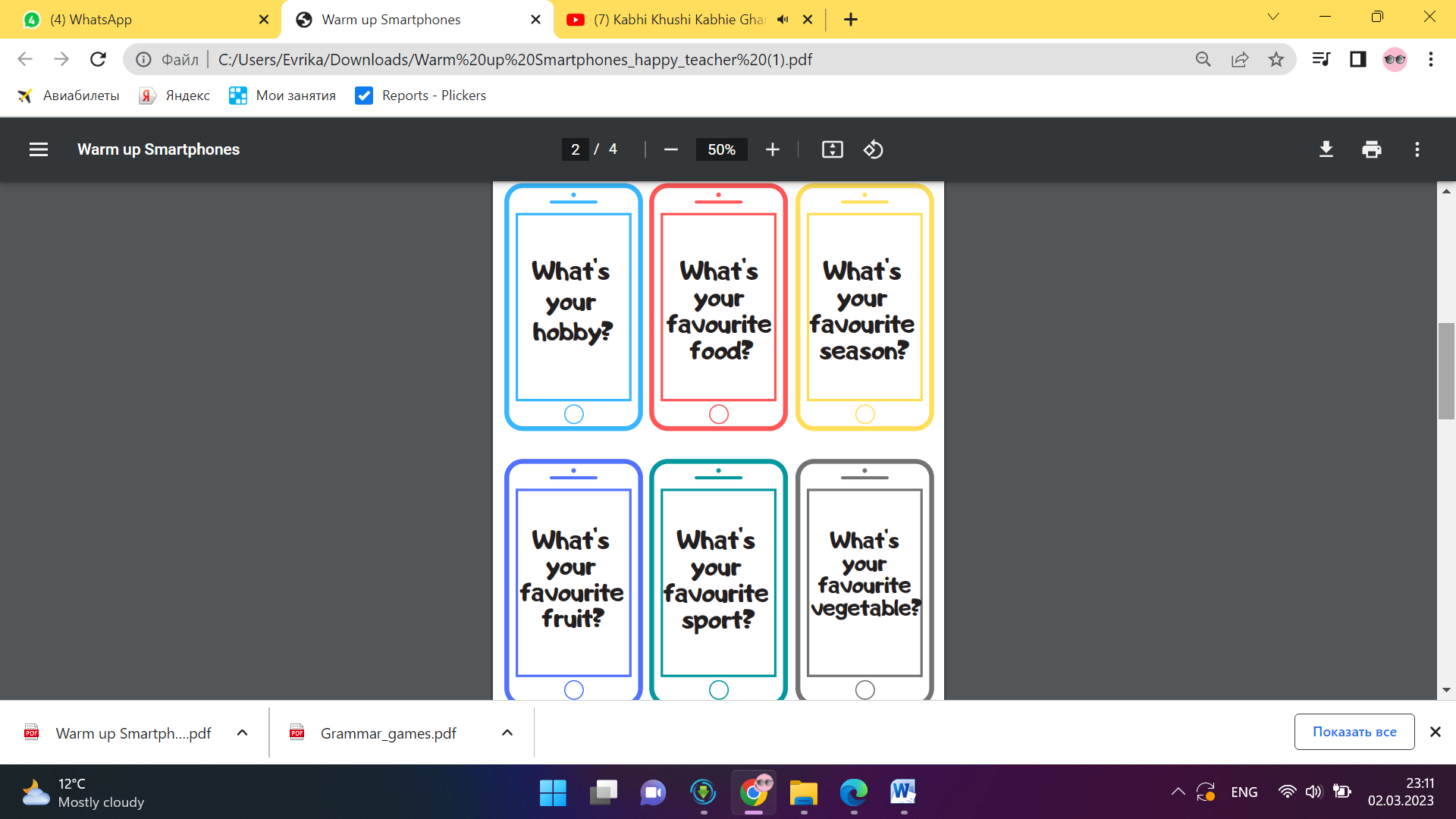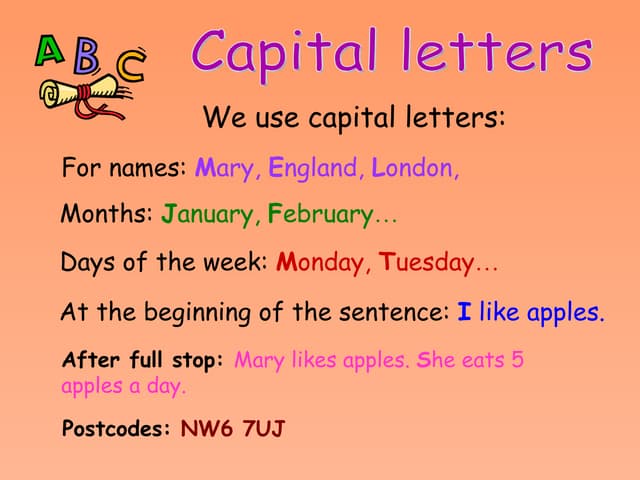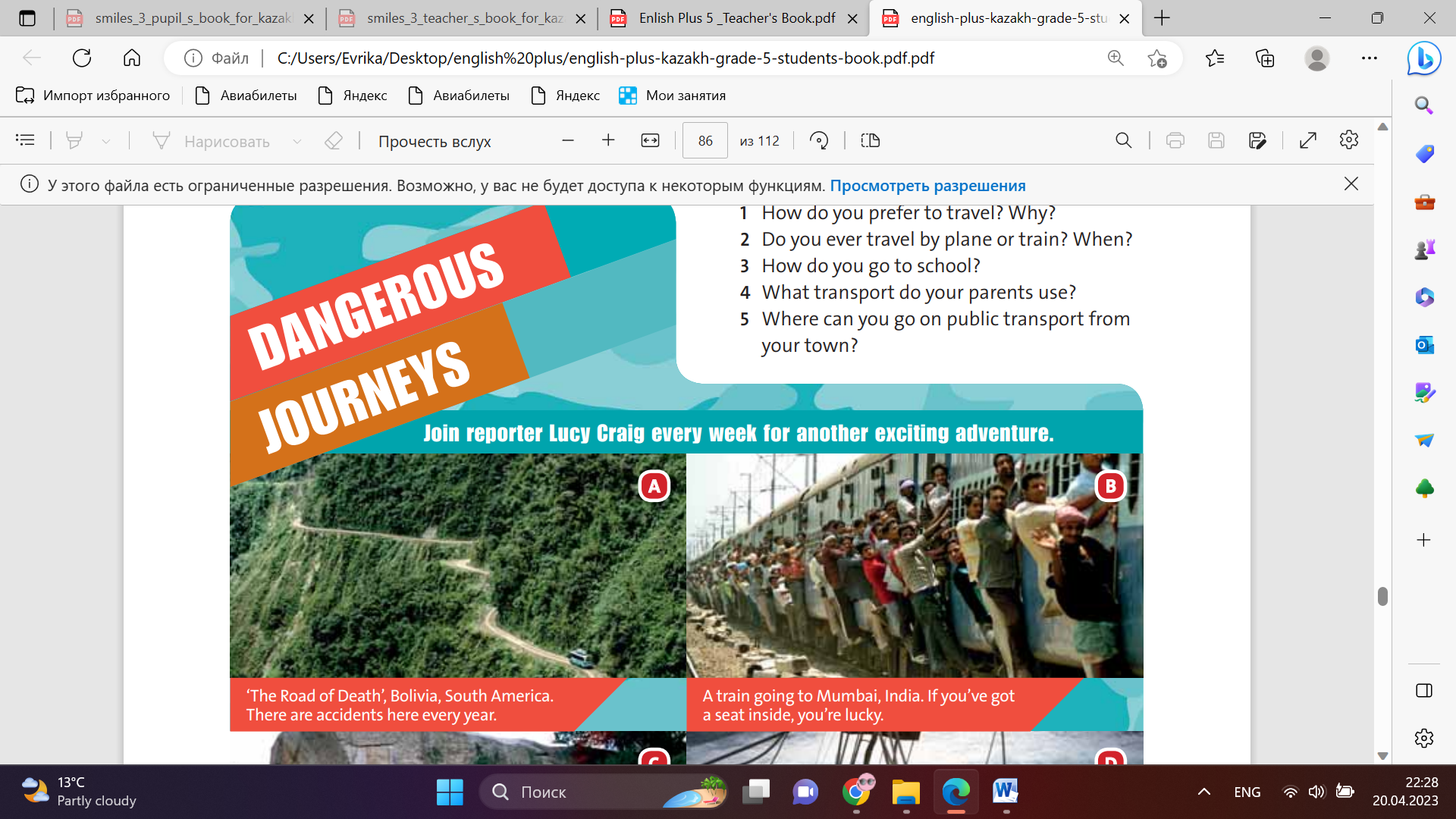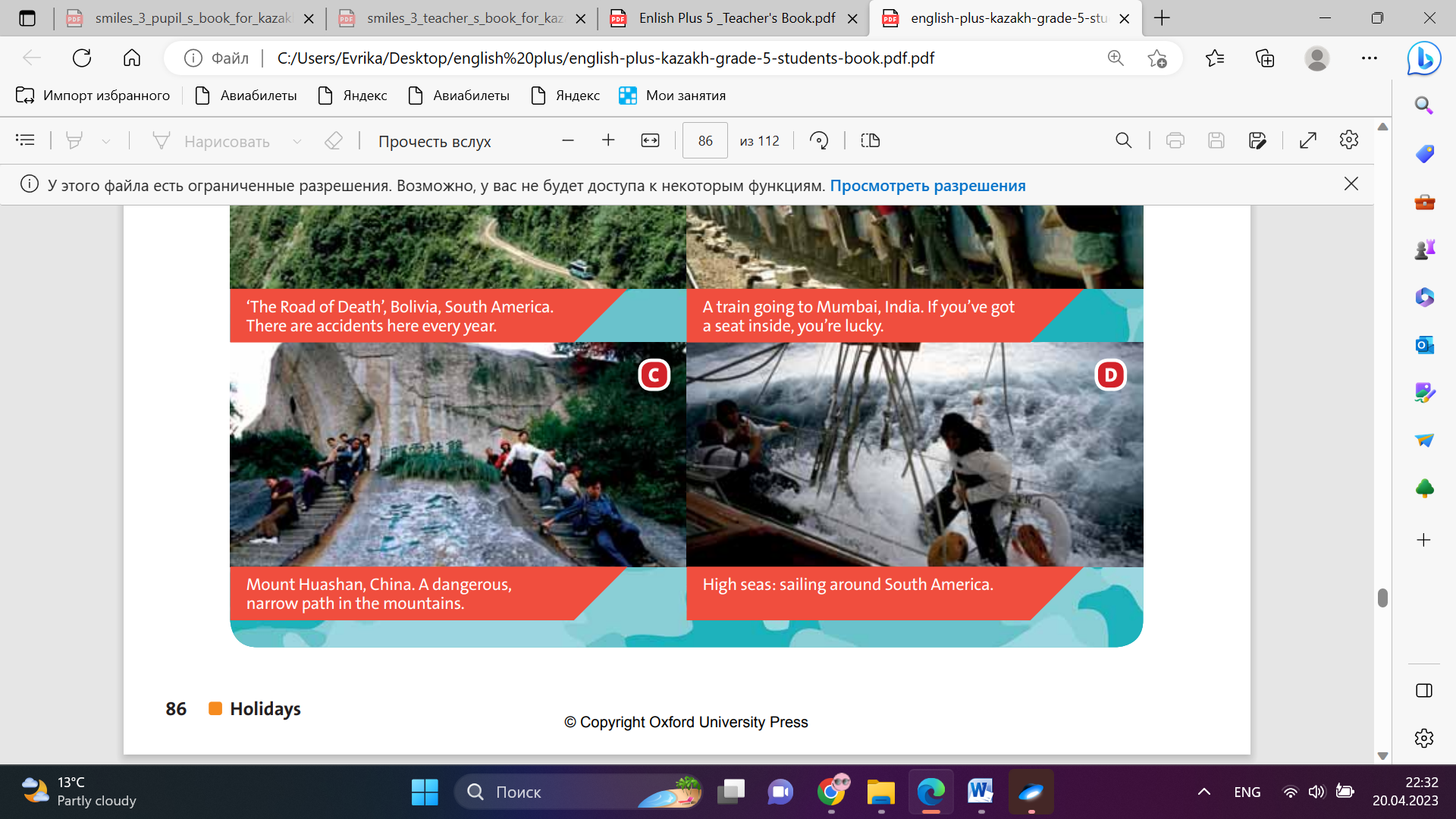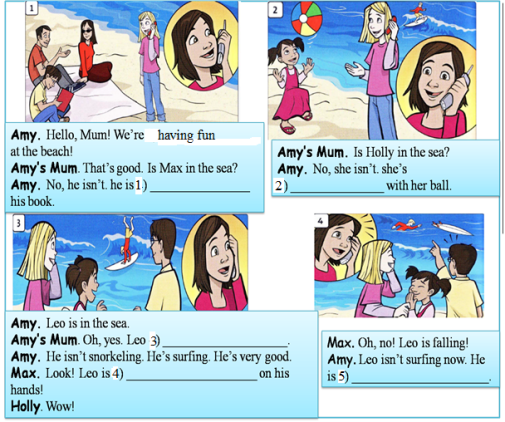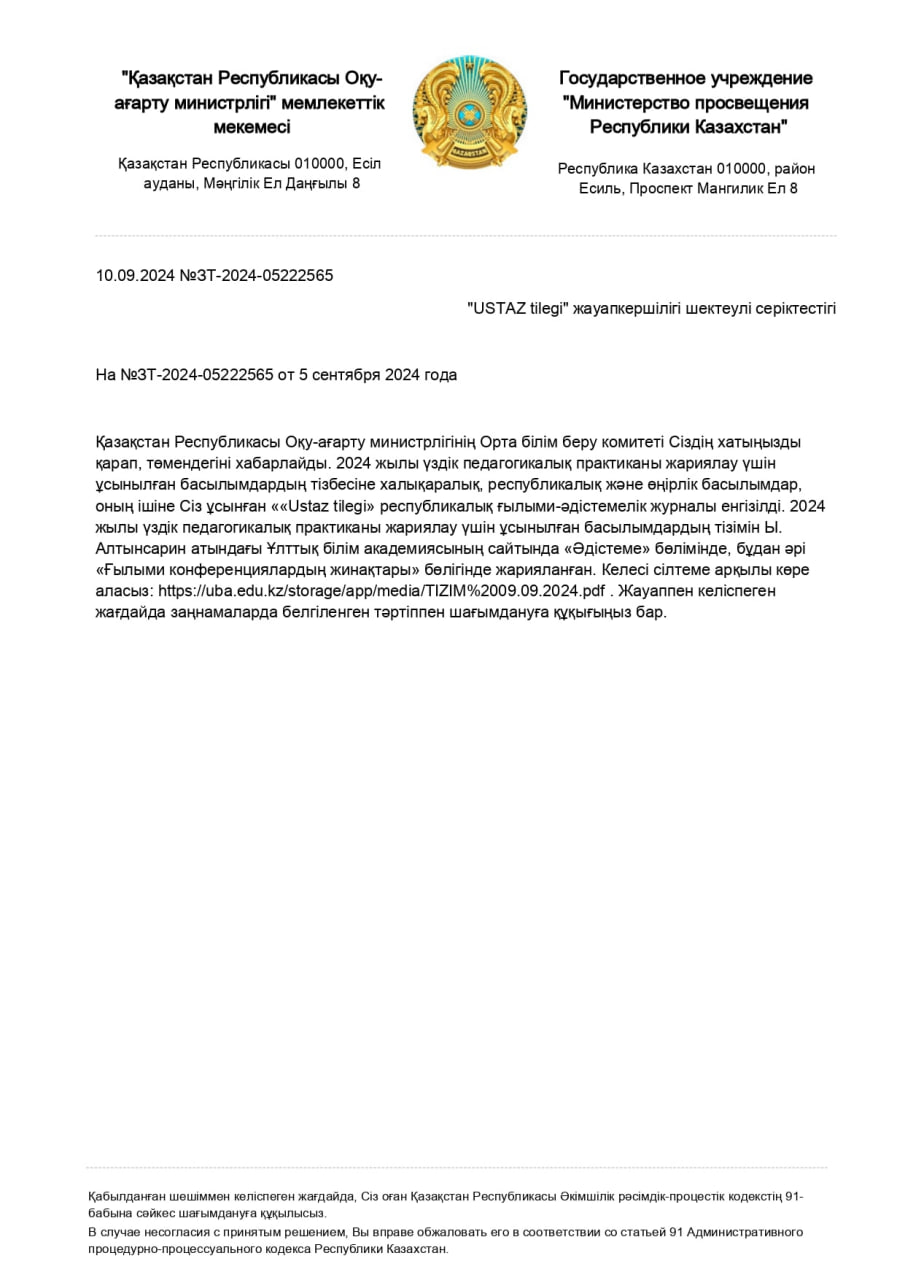жүктеу мүмкіндігіне ие боласыз
Бұл материал сайт қолданушысы жариялаған. Материалдың ішінде жазылған барлық ақпаратқа жауапкершілікті жариялаған қолданушы жауап береді. Ұстаз тілегі тек ақпаратты таратуға қолдау көрсетеді. Егер материал сіздің авторлық құқығыңызды бұзған болса немесе басқа да себептермен сайттан өшіру керек деп ойласаңыз осында жазыңыз

Бонусты жинап картаңызға (kaspi Gold, Halyk bank) шығарып аласыз
ҚМЖ жинағы English Plus 5-сынып 4-тоқсан

Short term plan: term 4
|
Unit: 2 Sports |
Lesson 81 |
||
|
Teacher name: |
|
||
|
Date: |
|
||
|
Grade: 5 |
Number present: |
absent: |
|
|
Lesson title |
I can describe people, places, things |
||
|
Learning objectives |
5.2.2.1 understand an increasing range of unsupported basic questions which ask for personal information; 5.3.4.1 respond with limited flexibility at sentence level to unexpected comments on an increasing range of general and curricular topics; 5.6.2.1 use appropriate adjectives and indefinite article a / an including common noun phrases describing things and activities on a limited range of familiar general and curricular topics. |
||
|
Lesson objectives |
Learners will be able to: • Learn and practise basic adjectives. • Learn how to use a and an correctly. |
||
|
Value links |
Hospitality: Traditionally a nomadic culture, hospitality has always been an important part of Kazakh culture. |
||
|
Plan |
|||
|
Stages / Time |
Teachers’ actions |
Students’ actions |
Assessment criteria |
Resources |
|
Beginning of the lesson 5 min |
Organization moment 1.Greeting. Ask about the weather. The teacher sets the lesson objectives, letting students know what to anticipate from the lesson. Warm-up
Fasten your seat belts and get ready for the all-round race Lead – In • Books closed. Ask the class to think about their town or city. In pairs, students should think of three words to describe it, e.g. big, small, etc. Allow them about 1 minute for this. • Get feedback from the class and write their suggestions on the board. |
Students' attention is drawn to the lesson. Students discuss the pictures in pairs. Determines the topic and aim of the lesson Students say different words from the picture |
Formative Assessment
Good job! Assessment criteria - Recognize basic personal questions without support - Provide unprepared speech to answer a variety of questions at sentence level with limited flexibility |
Pictures Student’s book |
|
Middle of the lesson Presentation part. 35 min |
Ex: 1 P:12 • Write treasure hunt on the board and translate it into the students’ own language. Ask the class if they know what it is. Elicit that a treasure hunt is when people use clues to find treasure or a prize. Ask if any of the students have ever been on a treasure hunt and elicit any feedback they provide. • In a weaker class, look at the example carefully together. You might also like to do the second clue together as a class before they continue in their pairs. .Ex: 2 P:12 • Write big and small on the board. Ask the students how these adjectives are connected and elicit that they have opposite meanings. • Encourage students to identify pairs of opposites that are easier first so that they will have fewer adjectives to guess from if they do not know. Students do the task in pairs. • Play the recording to check their answers as a class. Ex: 4 P:12 • Focus students’ attention on the examples and the rules. • In a stronger class, ask students to go ahead and complete the rules based on the examples. • In a weaker class, read the rules together and work out the answers as a class. Ex: 5 P:12 • Students complete the activity individually, using the rules from exercise 4 to help them if necessary. • Ask fast finishers to make more short descriptions using other adjectives from exercise 1with a and an. Conclusion during the lesson some tasks differentiated by outcomes of the students and by their abilities. |
Students do the adjectives Treasure Hunts. Answers: A big poster Differentiation: «Verbal support» method is used to help Students use new words in the text. Students look at the adjectives in exercise 1 and find five pairs of adjectives. The listen and check. Answers: (terrible – great; popular – unpopular; boring – interesting; difficult – easy) Students complete the rules with a and an Answers: 1 an 2 a Students complete with a or an Answers: 1 an 2 a 3 a 4 an 5 an 6 a 7 an 8 a |
Descriptor: - work in pairs - find a secret objects Total: 1 point Descriptor: - identify pairs of opposites - listen and check. Total: 1 point Descriptor: - complete the sentences Total: 1 point Descriptor: -write sentences -complete with a or an Total: 1 point |
flashcards Worksheets |
|
End of the lesson 5 min |
FEEDBACK Learners provide feedback on what they have learned at the lesson. |
|
Students evaluate each other and encourage classmate with phrases like: Well done! Brilliant! Good job! I like it! . |
Poster
|
Short term plan: term 4
|
Unit: 2 Sports |
Lesson 82 |
||
|
Teacher name: |
|
||
|
Date: |
|
||
|
Grade: 5 |
Number present: |
absent: |
|
|
Lesson title |
A web page about clubs for young people |
||
|
Learning objectives |
5.2.4.1 understand the main points of supported extended talk on a range of general and curricular topics 5.4.1.1 understand the main points in a limited range of short simple texts on general and curricular topics 5.3.2.1 ask simple questions to get information about a limited range of general topics |
||
|
Lesson objectives |
Learners will be able to: • Read about people’s hobbies. • Practise giving opinions about different hobbies. • Learn the days of the week. |
||
|
Value links |
Tradition: Kazakh traditions and culture have been passed on from one generation to another through oral histories told by traditional Kazakh tribal leaders and elders. |
||
|
Plan |
|||
|
Stages / Time |
Teachers’ actions |
Students’ actions |
Assessment criteria |
Resources |
|
Beginning of the lesson 5 min |
Organization moment 1.Greeting. Ask about the weather. The teacher sets the lesson objectives, letting students know what to anticipate from the lesson. Warm-up
Fasten your seat belts and get ready for the all-round race Lead – In • Books closed. Mime a simple everyday hobby to the class, e.g. reading. Ask the class to tell you what you are doing. Elicit that you are reading and write reading on the board. • Do the same for three more hobbies, e.g. running, photography and listening to music. Write the activity on the board each time and model for pronunciation. |
Students' attention is drawn to the lesson. Students discuss the pictures in pairs. Determines the topic and aim of the lesson Students say different words from the picture |
Formative Assessment
Good job! Assessment criteria - Identify the main information of a talk using supporting information - Read and identify the main idea in the text. |
Pictures Student’s book |
|
Middle of the lesson Presentation part. 35 min |
Ex: 1 P:14 • Focus on the four pictures and draw students’ attention to the headings of the paragraphs. Ask them to give you the names of these clubs in their own language. • Go through the example and point out that I think (that) is one way in which we can give an opinion. • In pairs, students discuss the different clubs, giving their opinions. Remind them to use adjectives from pages 12 and 13. Get feedback from the class by asking a few students about each club Ex: 2 P:14 • Ask students to look at the Cost and Difficulty subheadings at the end of each paragraph and to tell you what they think they mean (point out that difficulty is the noun form of difficult). Elicit that more $ signs mean the club is more expensive and more ! signs mean the club is more difficult. • Play the recording for students to listen to as they read. In a weaker class, pause the recording after each club and check for new vocabulary. • Explain the task. Encourage students to underline the text where they get their answer. In a stronger class, student can do the task alone. In a weaker class, do the first one together as an example and then let them continue in pairs. Ex: 3 P:14 • Draw students’ attention to the four days of the week in the exercise and ask them if they recognize what they are. Elicit that they are days of the week. • Point out that the other three are in the text. Students fill the gaps individually and check answers in pairs. Conclusion during the lesson some tasks differentiated by outcomes of the students and by their abilities. |
Students look at the pictures and the names of the clubs. Are they interesting pr boring? Answers: Students’ own answer Differentiation: «Verbal support» method is used to help Students use new words in the text. Students read and listen, then match Answers: 1 d 2 e 3 b 4 a 5 c Students complete the days of the week with words from the reading text. Answers: 1 an 2 a |
Descriptor: - look at the pictures and the names of the clubs Total: 1 point Descriptor: - listen each paragraph - match the sentences Total: 1 point Descriptor: - write the days of the week Total: 1 point |
flashcards Worksheets |
|
End of the lesson 5 min |
FEEDBACK Learners provide feedback on what they have learned at the lesson. |
|
Students evaluate each other and encourage classmate with phrases like: Well done! Brilliant! Good job! I like it! . |
Poster
|
Short term plan: term 4
|
Unit: 2 Sports |
Lesson 83 |
||
|
Teacher name: |
|
||
|
Date: |
|
||
|
Grade: 5 |
Number present: |
absent: |
|
|
Lesson title |
Language Focus: be(negative) |
||
|
Learning objectives |
5.4.1.1 understand the main points in a limited range of short simple texts on general and curricular topics 5.5.1.1 plan, write, edit and proofread work at text level with support on a limited range of general and curricular topics 5.6.8.1 use a verb to be to talk about favourite things on a limited range of familiar general and curricular topics |
||
|
Lesson objectives |
Learners will be able to: • Learn and practise the negative form of the verb be. • Learn to use on and at to talk about time. • Practise talking about clubs. |
||
|
Value links |
Freedom: Freedom is the major value of the civil society being formed in Kazakhstan. This must provide everyone with the possibility of creative self-realization. |
||
|
Plan |
|||
|
Stages / Time |
Teachers’ actions |
Students’ actions |
Assessment criteria |
Resources |
|
Beginning of the lesson 5 min |
Organization moment 1.Greeting. Ask about the weather. The teacher sets the lesson objectives, letting students know what to anticipate from the lesson. Warm-up
Fasten your seat belts and get ready for the all-round race Lead – In • Books closed. Say to the class I am. Point to a stronger student and say You are. Gesture for this student to continue with I am and that he / she should point to another student in turn and continue with you are, and so on. Continue around the class, adding he is, she is, we are and they are. Get students in turn to point to appropriate individuals or groups and say the correct form of the verb be. |
Students' attention is drawn to the lesson. Students discuss the pictures in pairs. Determines the topic and aim of the lesson Students say different words from the picture |
Formative Assessment
Good job! Assessment criteria - Identify the main information of a talk using supporting information - Read and identify the main idea in the text. |
Pictures Student’s book |
|
Middle of the lesson Presentation part. 35 min |
Ex: 1 P:15 • Focus students on the left-hand column of the table and ask what they can see. Elicit that these are the affirmative forms of the verb be. Ask them what else they notice about these verbs and elicit that they are in the short form. • Point out that the right-hand column contains verbs that are negative. We form the negative by using the word not after the verb be. Read each long form out and ask students to repeat after you Ex: 2 P:15 • With the students look at the illustration of the pupils climbing the school building. Ask them what they see and elicit that there are two students climbing outside the school. Ask them if the teacher looks happy and elicit that the teacher doesn’t look happy. • Explain the task. All students should be able to do this activity on their own, but circulate while the students are working and offer help if necessary Ex: 3 P:15 • Tell students to think about their own lives as they complete the gaps and to decide on the affirmative or negative accordingly. Check answers as a class.. • If time allows, you could extend the activity by asking students to work individually to write three sentences, two true and one false. • They then work in pairs and read each other their sentences. Their partner has to guess which sentence is false. Conclusion during the lesson some tasks differentiated by outcomes of the students and by their abilities. |
Students find negative forms in the text. Answers: 1 She isn’t 2 We aren’t 3 They aren’t Differentiation: «Verbal support» method is used to help Students use new words in the text. Students choose the correct words Answers: 1 is 2 aren’t 3 are 4 isn’t 5 ’m not 6 are Students make true sentences. Use the correct form of to be Answers: Students’ own answers |
Descriptor: - find negative forms Total: 1 point Descriptor: - look at the picture - choose the correct words Total: 1 point Descriptor: - complete the gaps - make true sentences Total: 1 point Total point :10 |
flashcards Worksheets |
|
End of the lesson 5 min |
FEEDBACK Learners provide feedback on what they have learned at the lesson. |
|
Students evaluate each other and encourage classmate with phrases like: Well done! Brilliant! Good job! I like it! . |
Poster
|
Short term plan: term 4
|
Unit: 2 Sports |
Lesson 84 |
||
|
Teacher name: |
|
||
|
Date: 03.04.23 |
|
||
|
Grade: 5 |
Number present: |
absent: |
|
|
Lesson title |
Nouns: favourite things. |
||
|
Learning objectives |
5.6.8.1 use a verb to be to talk about favourite things on a limited range of familiar general and curricular topics 5.2.4.1 understand the main points of supported extended talk on a range of general and curricular topics 5.3.2.1 ask simple questions to get information about a limited range of general topics. |
||
|
Lesson objectives |
Learners will be able to: • Learn vocabulary to talk about favourite things. • Practise talking about favourite things |
||
|
Value links |
Hospitality: Traditionally a nomadic culture, hospitality has always been an important part of Kazakh culture. |
||
|
Plan |
|||
|
Stages / Time |
Teachers’ actions |
Students’ actions |
Assessment criteria |
Resources |
|
Beginning of the lesson 5 min |
Organization moment 1.Greeting. Ask about the weather. The teacher sets the lesson objectives, letting students know what to anticipate from the lesson. Warm-up
Fasten your seat belts and get ready for the all-round race Lead – In • Books closed. Write the following words on the board: chocolate, cake, ice-cream. Ask the class if they know what these words are and get some feedback. • Write the question What is your favourite? on the board and explain what it means. Say: My favourite thing is chocolate. • In pairs, students decide what is their favourite thing from the items on the board. Get feedback from the class by asking each student to say My favourite thing is … |
Students' attention is drawn to the lesson. Students discuss the pictures in pairs. Determines the topic and aim of the lesson Students say different words from the picture |
Formative Assessment
Good job! Assessment criteria - Identify the main information of a talk using supporting information - Read and identify the main idea in the text. |
Pictures Student’s book |
|
Middle of the lesson Presentation part. 35 min |
Ex: 1 P:16 • Focus on the table and on the words in the left-hand column. Read through them with the class, checking for understanding. • Students do the task in pairs. Circulate and monitor, helping out where necessary. Encourage students to match the words they recognize first Ex: 2 P:16 • Ask students to work individually to think of their own examples. Circulate, helping with new words where necessary. . • Encourage students to use full sentences when guessing what their partner means, e.g. they should say Pizza is a food, not just food. • Monitor students as they speak, listening out for correct sentence structures. Ex: 3 P:16 • Refer students to the five photos and ask: What do you see in photo 1? Elicit Lady Gaga is in photo 1. Continue like this with the rest of the photos. • Explain that this is a quiz about some of the most popular things in the world. In a stronger class, ask students to go ahead and do the task in pairs. • In a weaker class, go through the questions together as a class, explaining any new vocabulary, before asking the students to do the task. Conclusion during the lesson some tasks differentiated by outcomes of the students and by their abilities. |
Students match the words in columns A and B. make sentences Answers: 1 Blue is a colour. 2 Angry Birds is a game. 3 A dog is an animal. . 4 Basketball is a sport. 5 Jessie J is a singer 6 The Simpsons is a TV programme. 7 CSK Moscow is a team. 8 The Hobbit is a film 9 Angelina Jolie is a film star. Differentiation: «Verbal support» method is used to help Students use new words in the text. Students think of more examples then work in pairs. Answers: Students’ own answers Students answer the quiz questions in pairs. Then listen to the TV quiz. Answers: 1 a 2 a 3 a 4 b 5 a |
Descriptor: - match the words in columns Total: 1 point Descriptor: - work individually - think of more examples Total: 1 point Descriptor: - answer the quiz questions - listen to the TV quiz. Total point :10 |
flashcards Worksheets |
|
End of the lesson 5 min |
FEEDBACK Learners provide feedback on what they have learned at the lesson. |
|
Students evaluate each other and encourage classmate with phrases like: Well done! Brilliant! Good job! I like it! . |
Poster
|
Short term plan: term 4
|
Unit: 2 Sports |
Lesson 85 |
||
|
Teacher name: |
|
||
|
Date: 05.04.23 |
|
||
|
Grade: 5 |
Number present: |
absent: |
|
|
Lesson title |
Questions and short answers A verb: be. |
||
|
Learning objectives |
5.5.1.1 plan, write, edit and proofread work at text level with support on a limited range of general and curricular topics 5.6.8.1 use a verb to be to talk about favourite things on a limited range of familiar general and curricular topics 5.2.4.1 understand the main points of supported extended talk on a range of general and curricular topics 5.3.2.1 ask simple questions to get information about a limited range of general topics. |
||
|
Lesson objectives |
Learners will be able to: • Learn how to use be in questions and short answers. • Further practice of talking about favourite things |
||
|
Value links |
Tradition: Kazakh traditions and culture have been passed on from one generation to another through oral histories told by traditional Kazakh tribal leaders and elders. |
||
|
Plan |
|||
|
Stages / Time |
Teachers’ actions |
Students’ actions |
Assessment criteria |
Resources |
|
Beginning of the lesson 5 min |
Organization moment 1.Greeting. Ask about the weather. The teacher sets the lesson objectives, letting students know what to anticipate from the lesson. Warm-up
Fasten your seat belts and get ready for the all-round race Lead – In • Books closed. Tell students to work in pairs. They imagine that they have one chance to ask one question from their favourite celebrity. • In pairs, students decide on their question and which celebrity they would ask. Get feedback from each pair, writing their question and any new vocabulary on the board. |
Students' attention is drawn to the lesson. Students discuss the pictures in pairs. Determines the topic and aim of the lesson Students say different words from the picture |
Formative Assessment
Good job! Assessment criteria - Identify the main information of a talk using supporting information - Read and identify the main idea in the text. |
Pictures Student’s book |
|
Middle of the lesson Presentation part. 35 min |
Ex: 1 P:17 • Explain the task. In a stronger class, ask students to complete the task individually. In a weaker class, students complete the task in pairs. LANGUAGE NOTE To form questions with the verb be, we
simply invert the verb and the subject, e.g. She is from the USA –
Is she from the USA? If there are question words, they go in front
of the verb be, e.g. Where is she from? How old is she? It is
common to answer questions using short answers, but short
affirmative answers with the verb be are not contracted, i.e. we
say Yes, I am, not Ex: 2 P:17 • Ask students to look at the photos at the bottom of the page. Do they recognize the cities in two of the photos? Do they recognize the football teams in the second photo? Allow them 1–2 minutes to discuss in pairs. • Elicit that the first photo is of Shanghai. The third photo is of Rio de Janeiro. The second photo shows players from the national football teams of Spain (left) and Portugal (right). • Explain the task to the class. In a weaker class, point out that students should look for the subject of the sentence to decide what form of the verb be to use. Ex: 3 P:17 • Divide students into pairs. In a weaker class, allow the students to read the questions. In a stronger class, students should be able to do the task without having to read the questions • Monitor, helping out where necessary and listening for correct use of question forms and short answer forms. Check answers as a class Conclusion during the lesson some tasks differentiated by outcomes of the students and by their abilities. |
Students complete the questions and answers. Then listen and check. Answers: 1 I’m 2 Is 3 isn’t 4 are 5 they Differentiation: «Verbal support» method is used to help Students use new words in the text. Students complete the questions and write short answers Answers: 1 Are 2 Is 3 Are 4 Is 5 Is 6 Is 7 Are 8 Is Students work in pairs ask and answer the questions Answers: 1 Yes, I am. or No I’m not. 2 Yes, she is. or No, she isn’t. 3 Yes, we are. or No, we aren’t. 4 Yes, it is. 5 Yes, it is. or No, it isn’t. 6 No, he isn’t. 7 Yes, they are. 8 Yes it is. or No, it isn’t. |
Descriptor: - complete the task individually - complete the questions and answers Total: 1 point Descriptor: - group work - complete the questions - write short answers Total: 1 point Descriptor: - work in pairs - ask and answer the questions Total: 1 point Total point :10 |
flashcards Worksheets |
|
End of the lesson 5 min |
FEEDBACK Learners provide feedback on what they have learned at the lesson. |
|
Students evaluate each other and encourage classmate with phrases like: Well done! Brilliant! Good job! I like it! . |
Poster
|
Short term plan: term 4
|
Unit: 2 Sports |
Lesson 86 |
||
|
Teacher name: |
|
||
|
Date: |
|
||
|
Grade: 5 |
Number present: |
absent: |
|
|
Lesson title |
Giving personal information |
||
|
Learning objectives |
5.4.1.1 understand the main points in a limited range of short simple texts on general and curricular topics 5.6.8.1 use a verb to be to talk about favourite things on a limited range of familiar general and curricular topics 5.3.4.1 respond with limited flexibility at sentence level to unexpected comments on an increasing range of general and curricular topics |
||
|
Lesson objectives |
Learners will be able to: • Practise responding to questions. • Learn and practise the letters of the alphabet. |
||
|
Value links |
Freedom: Freedom is the major value of the civil society being formed in Kazakhstan. This must provide everyone with the possibility of creative self-realization. |
||
|
Plan |
|||
|
Stages / Time |
Teachers’ actions |
Students’ actions |
Assessment criteria |
Resources |
|
Beginning of the lesson 5 min |
Organization moment 1.Greeting. Ask about the weather. The teacher sets the lesson objectives, letting students know what to anticipate from the lesson. Warm-up
Fasten your seat belts and get ready for the all-round race Lead – In • Books closed. Say to the class: My name’s (your name). Then turn to the student closest to you and say What’s your name? That student says My name’s (name) and then turns to the next student asking What’s your name? • Students continue around the classroom saying their name and asking the next student what their name is. |
Students' attention is drawn to the lesson. Students discuss the pictures in pairs. Determines the topic and aim of the lesson Students say different words from the picture |
Formative Assessment
Good job! Assessment criteria - Identify the main information of a talk using supporting information - Read and identify the main idea in the text. |
Pictures Student’s book |
|
Middle of the lesson Presentation part. 35 min |
Ex: 1 P:18 • Focus on the photo and discuss it with the class. Ask the students what they can see and elicit that there is a boy at the reception of a club. Ask them what kind of club they think it is and elicit any answers. Ex: 2 P:18 • Students follow the dialogue as they listen. • In a weaker class, you could pause the recording after each line and ask students to repeat. • Ask the class what Tom is doing. Elicit that Tom is joining the club Ex: 3 P:18 • Refer students to the key phrases. Explain the task. • Students work individually. Check answers as a class. T • In a weaker class, translate the key phrases together. Ask stronger students to translate the sentences by themselves into their own language. • Divide students into pairs to practise the dialogue. You might like to play the recording once more for them to help them. Monitor, helping out with pronunciation issues where necessary Conclusion during the lesson some tasks differentiated by outcomes of the students and by their abilities. |
Students look at the photo. What club is Tom interested in? Answers: Tom is interested in a sports club. Differentiation: «Verbal support» method is used to help Students use new words in the text. Students listen to the dialogue. Answers: Student’s own answer. Students complete the key phrases from the dialogue. Then practise the dialogue. Answers: Can you spell that, please? What’s your phone number? Welcome to the club! |
Descriptor: - look at the photo - discuss about the photo Total: 1 point Descriptor: - group work - listen to the dialogue. Total: 1 point Descriptor: - work individually - complete the key phrases Total: 1 point Total point :10 |
flashcards Worksheets |
|
End of the lesson 5 min |
FEEDBACK Learners provide feedback on what they have learned at the lesson. |
|
Students evaluate each other and encourage classmate with phrases like: Well done! Brilliant! Good job! I like it! . |
Poster
|
Short term plan: term 4
|
Unit: 2 Sports |
Lesson 87 |
||
|
Teacher name: |
|
||
|
Date: 10.04.23 |
|
||
|
Grade: 5 |
Number present: |
absent: |
|
|
Lesson title |
An email |
||
|
Learning objectives |
5.5.6.1 link, with some support, sentences into coherent paragraphs using basic connectors on a limited range of familiar general topics 5.6.10.1 use present simple to write an email to an internet friend 5.4.1.1 understand the main points in a limited range of short simple texts on general and curricular topics. |
||
|
Lesson objectives |
Learners will be able to: • Learn the structure of an email. • Learn key phrases to use in an email. • Practise writing an email about yourself |
||
|
Value links |
Patriotism: The formation of civil society institutions is impossible without the development of a patriotism shared by the entire Kazakhstan, and with deep roots in the culture, psychology, and historical past of the Kazakhs. |
||
|
Plan |
|||
|
Stages / Time |
Teachers’ actions |
Students’ actions |
Assessment criteria |
Resources |
|
Beginning of the lesson 5 min |
Organization moment 1.Greeting. Ask about the weather. The teacher sets the lesson objectives, letting students know what to anticipate from the lesson. Warm-up Method speaking phone was used to develop speaking skills.
Lead – In • Books closed. Ask the class: Do you like to email or do you like to send text messages? Repeat the question if necessary and check for understanding. • Ask a stronger student to answer the question, e.g. I like to send text messages. Encourage other students in the class to answer the questions for themselves too. |
Students' attention is drawn to the lesson. Students discuss the pictures in pairs. Determines the topic and aim of the lesson Students say different words from the picture |
Formative Assessment
Good job! Assessment criteria - Identify the main information of a talk using supporting information - Read and identify the main idea in the text. |
Pictures Student’s book |
|
Middle of the lesson Presentation part. 35 min |
Ex: 1 P:19 • Focus on the photos and ask the class which photo they prefer. Elicit any answers and encourage students to give reasons if they can. • Allow students 2–3 minutes to do the task. They check their answers in pairs. Check answers as a class. • Ask the class if they think that Matthew is interesting. Elicit any feedback the class give, e.g. I think he is interesting because he likes good music Ex: 2 P:19 • Refer students to the key phrases. Explain the task. • Students work individually. Check answers as a class. • In a weaker class, translate the key phrases together. Ask stronger student to translate the sentences by themselves into their own language Ex: 3 P:19 • Read through the different items together and check for understanding. • You could make the activity competitive by telling students that the first student to find an example of each is the winner. • Check answers as a class
Conclusion during the lesson some tasks differentiated by outcomes of the students and by their abilities. |
Students read the model text and choose the correct photo of Matthew from A and B Answers: A Differentiation: «Verbal support» method is used to help Students use new words in the text. Students complete the key phrases. Then look at the model text and check your answer. Answers: 1 like 2 also 3 fan 4 interested 5 Please
Students find words in the text that start with capital letters. Match the words to descriptions. Answers: Possible answers: 1 Matthew 2 England 3 Newcastle United 4 Newcastle 5 English 6 My name’s … Total point :10 |
Descriptor: - read the model text - choose the correct photo Total: 1 point Descriptor: - work individually - complete the key phrases Total: 1 point Descriptor: - find words in the text that start with capital letters - Match the words Total: 1 point |
flashcards Worksheets |
|
End of the lesson 5 min |
FEEDBACK Learners provide feedback on what they have learned at the lesson. |
|
Students evaluate each other and encourage classmate with phrases like: Well done! Brilliant! Good job! I like it! . |
Poster
|
Short term plan: term 4
|
Unit: 2 Sports |
Lesson 88 |
||
|
Teacher name: |
|
||
|
Date: 12.04.23 |
|
||
|
Grade: 5 |
Number present: |
absent: |
|
|
Lesson title |
My Country. Sports |
||
|
Learning objectives |
5.4.1.1 understand the main points in a limited range of short simple texts on general and curricular topics 5.5.1.1 plan, write, edit and proofread work at text level with support on a limited range of general and curricular topics 5.3.4.1 respond with limited flexibility at sentence level to unexpected comments on an increasing range of general and curricular topics. |
||
|
Lesson objectives |
Learners will be able to: • Learn vocabulary for talking about sports. • Read a text about popular sports in Kazakhstan. • Learn how to use this, that, these and those. |
||
|
Value links |
Respect: Respect of elders and of the spiritual freedom of other nations are principal values. It is important to develop a productive dialogue between confessions and to acknowledge religion as an element of civil society. |
||
|
Plan |
|||
|
Stages / Time |
Teachers’ actions |
Students’ actions |
Assessment criteria |
Resources |
|
Beginning of the lesson 5 min |
Organization moment 1.Greeting. Ask about the weather. The teacher sets the lesson objectives, letting students know what to anticipate from the lesson. Warm-up Method speaking phone was used to develop speaking skills.
Lead – In • Books closed. Divide students into pairs and write sports on the board. • Allow students about 2 minutes to tell each other about their favourite sport. • Get feedback from the class by asking a few students to say what sport their partner likes best and why. |
Students' attention is drawn to the lesson. Students discuss the pictures in pairs. Determines the topic and aim of the lesson Students say different words from the picture |
Formative Assessment
Good job! Assessment criteria - Identify the main information of a talk using supporting information - Read and identify the main idea in the text. |
Pictures Student’s book |
|
Middle of the lesson Presentation part. 35 min |
Ex: 1 P:20 • Focus students’ attention on the words in the box. Point out that some of the words are similar in Kazakh. • Students work in pairs to identify the words that are similar in Kazakh and English. Encourage them to try to guess the meaning of all the words before they look them up in a dictionary. • Check answers by asking students to give an example of a famous sportsperson for each sport. • Model and drill the pronunciation of the words. Ex: 2 P:20 • Focus students’ attention on the photos. Ask them to identify the sports in the photos (horse riding, cycling and judo). Then tell students to read the texts quickly and check their answers. • Read through the questions together and check understanding. • Students check their answers in pairs. Ex: 3 P:20 • Draw students’ attention to the words in blue. • Students complete the rules and check answers in pairs. • Check answers as a class. Draw the following table on the board and asks students to complete it with this, that, these and those: Ex: 4 P:20 • Explain the task and ask students to do it individually. • Check answers as a class Conclusion during the lesson some tasks differentiated by outcomes of the students and by their abilities. |
Students use these words in your dictionary. Differentiation: «Verbal support» method is used to help Students use new words in the text. Answers: The following words are similar in Kazakh: football, boxing, judo, tennis, hockey, golf, gymnastics. Students read and listen to the text. Answer the questions. Answers: 1 12 2 horse riding 3 Inzhu 4 Inzhu’s cousins 5 Almaty 6 the judo club Students look at the words in blue in the text. Then choose the correct words to complete the rules. Answers: 1 point to 2 singular, plural 3 are, aren’t Students complete the sentences with this, these, that, those Answers: 1 this 2 those 3 these 4 that 5 This |
Descriptor: - work in pairs - identify the words that are similar in Kazakh and English. Total: 1 point. Descriptor: - work individually - answer the question Total: 1 poin Descriptor: - attention to the words in blue - complete the rules Total: 1 point Descriptor: - do the task individually Total: 1 point |
flashcards Worksheets |
|
End of the lesson 5 min |
FEEDBACK Learners provide feedback on what they have learned at the lesson. |
|
Students evaluate each other and encourage classmate with phrases like: Well done! Brilliant! Good job! I like it! . |
Poster
|
Short term plan: term 4
|
Unit: 2 Sports |
Lesson 89 |
||
|
Teacher name: |
|
||
|
Date: |
|
||
|
Grade: 5 |
Number present: |
absent: |
|
|
Lesson title |
Time and activities |
||
|
Learning objectives |
5.3.6.1 communicate meaning clearly at sentence level during, pair, group and whole class exchanges 5.2.2.1 understand an increasing range of unsupported basic questions which ask for personal information 5.6.2.1 use numbers to practise asking for and telling the time |
||
|
Lesson objectives |
Learners will be able to: • Learn how to ask for and tell the time. • Understand a conversation about activities. • Practise asking for and telling the time. |
||
|
Value links |
Respect - treating people with respect, value and courtesy. Especially apologising to them where the situation calls for it. |
||
|
Plan |
|||
|
Stages / Time |
Teachers’ actions |
Students’ actions |
Assessment criteria |
Resources |
|
Beginning of the lesson 5 min |
Organization moment 1.Greeting. Ask about the weather. The teacher sets the lesson objectives, letting students know what to anticipate from the lesson. Warm-up Method speaking phone was used to develop speaking skills.
Lead – In • Write some times on the board in digital format, e.g. 11:35, 14:05, 12:00, 16:30, 20:20. Ask students to decide which are in the afternoon (p.m.) and which are in the morning (a.m.). • Ask students to work in pairs and draw the times as they would appear on a clock face. Check answers as a class by drawing the clock faces on the board |
Students' attention is drawn to the lesson. Students discuss the pictures in pairs. Determines the topic and aim of the lesson Students say different words from the picture |
Formative Assessment
Good job! Assessment criteria - Identify the main information of a talk using supporting information - Read and identify the main idea in the text. |
Pictures Student’s book |
|
Middle of the lesson Presentation part. 35 min |
Ex: 1 P:21 • Focus students’ attention on the times in the box and on the six clock faces. Divide students into pairs and ask them to do the task. • Check answers as a class. Point out the words half, quarter, past and to. Explain that half means thirty minutes and quarter means fifteen minutes. Explain that we use past for times within the first thirty minutes after an hour and that we use to when talking about times in the thirty minutes before an hour Ex: 2 P:21 • Draw students’ attention to the empty clock faces and explain the task. • Play the recording. Pause after each time to allow students time to fill in the clock faces. • Students compare their clock faces in pairs. Check answers as a class Ex: 3 P:21 • Ask the students to work in pairs to rank the clubs according to how interesting they think they would be. Get some feedback from each pair. • Explain the task and draw students’ attention to the question. • Play the recording. Students check their answers in pairs. Check answers as a class. Elicit that the other activity mentioned is basketball. Ex: 4 P:21 • Refer students to the key phrases and read through them together as a class. Point out the two different ways to ask when something is happening. • Draw students’ attention to the web page and ask what kind of information it contains. Elicit that it contains the day and time for five different activity clubs. Conclusion during the lesson some tasks differentiated by outcomes of the students and by their abilities. |
Students match the times in the box with clocks. Then say times. Answers: 1 quarter past two 2 quarter to ten 3 eight o’clock 4 five past eleven 5 half past three 6 twenty to six Differentiation: «Verbal support» method is used to help Students use new words in the text. Students listen and draw the times you hear. Then listen and repeat. Answers: 1 half past eight 2 ten to two \ 3 quarter past ten 4 eleven o’clock 5 quarter to one 6 twenty five past three Students listen to a conversation. What activity is Lily interested in? Answers: 1 Tuesday 2 Saturday 3 12.15 4 2.30 Students study the key phrases. Then listen to the conversation again and complete the web page. Answers: Student’s own answer |
Descriptor: - attention on the times in the box - match the times in the box Total: 1 point. Descriptor: - attention to the empty clock faces - compare their clock faces Total: 1 point can listen to a conversation Total: 1 point Answers: Lily is interested in the music club. Descriptor: - work in pairs - listen to a conversation Total: 1 point Descriptor: - study the key phrases |
flashcards Worksheets |
|
End of the lesson 5 min |
FEEDBACK Learners provide feedback on what they have learned at the lesson. |
|
Students evaluate each other and encourage classmate with phrases like: Well done! Brilliant! Good job! I like it! . |
Poster
|
Short term plan: term 4
|
Unit: 2 Sports |
Lesson 90 |
||
|
Teacher’s name: |
|
||
|
Date: |
|
||
|
Grade: 5 |
Number present: |
absent: |
|
|
Lesson title |
A Club poster |
||
|
Learning objectives |
5.3.4.1 respond with limited flexibility at sentence level to unexpected comments on an increasing range of general and curricular topics; 5.1.2.1 use speaking and listening skills to provide sensitive feedback to peers; 5.4.2.1 understand with little support specific information and detail in short, simple texts on a limited range of general and curricular topics. |
||
|
Lesson objectives |
Learners will be able to: • Learn how to read information on a poster. • Make a poster for a club |
||
|
Plan |
|||
|
Stages / Time |
Teachers’ actions |
Students’ actions |
Assessment criteria |
Resources |
|
Beginning of the lesson 5 min |
Organization moment 1.Greeting. Ask about the weather. The teacher sets the lesson objectives, letting students know what to anticipate from the lesson. Warm-up Method speaking phone was used to develop speaking skills.
Lead – In • Books closed. Tell students to work in pairs and tell each other what club they would join if they could choose one. • After about 1–2 minutes, get some feedback from the class by asking a few students to tell you about their partner’s chosen club. |
Students' attention is drawn to the lesson. Students discuss the pictures in pairs. Determines the topic and aim of the lesson Students say different words from the picture |
Formative Assessment
Good job! Assessment criteria - Identify the main information of a talk using supporting information - Read and identify the main idea in the text. |
Pictures Student’s book |
|
Middle of the lesson Presentation part. 35 min |
Ex: 1 P:22 • Refer students to the poster and ask them if they like it. Elicit any feedback they give you and encourage them to give reasons for their opinions. • Ask them what the poster is about and elicit it is about a photography club. • Explain the task and divide students into pairs. Ask them to skim read the information, i.e. they should look for the information quickly without reading for detail. Encourage students to underline the information on the poster as they find it Ex: 2 P:22 • Draw students’ attention to the questions and allow them a moment to read through them. • Students do the task individually and check their answers in pairs. Check answers as a class. • Alternatively, you could make the exercise more competitive and ask students to work in pairs to find the information on the poster. The first pair to answer all the questions wins Ex: 3 P:22 • Divide students into pairs or small groups of three, whichever you think will work best. Read through the instructions for making a poster with them and check that they understand what they have to do • Firstly, allow them some time to agree with each other on what type of club they are going to put on their poster. Monitor and help with ideas if necessary. If possible, try to avoid two groups choosing the same type of club so that there can be some variety. • Students write their information together in their groups. Circulate, checking that they are including the relevant information and remind them to check their work for mistakes in spelling and grammar Conclusion during the lesson some tasks differentiated by outcomes of the students and by their abilities. |
Students read Roza’s poster. What information in the poster? Answers: The poster tells us about the cost, the place, the time and the age of the club members. Differentiation: «Verbal support» method is used to help Students use new words in the text. Students read the poster and answer the question. Answers: 1 The club is for young people from ten to sixteen years old. 2 The club is on Tuesdays. 3 The club takes place between four and seven o’clock. 4 The club is at the youth centre in Orynbor Street.\ 5 Roza Rymbayeva is the instructor at the club. Students make a poster for a club. Follow the steps in the project Checklist. Answers: Students’ own answers |
Descriptor: - read the information by skimming Total: 1 point. Descriptor: - do the task individually - read the poster and answer the question Total: 1 point Descriptor: - work in groups - listen to a conversation - write their information together in their groups Total: 1 point |
flashcards Worksheets |
|
End of the lesson 5 min |
FEEDBACK Learners provide feedback on what they have learned at the lesson. |
|
Students evaluate each other and encourage classmate with phrases like: Well done! Brilliant! Good job! I like it! . |
Poster
|
Short term plan: term 4
|
Unit: 2 Sports |
Lesson 92 |
||
|
Teache’s name: |
|
||
|
Date: 19.04.23 |
|
||
|
Grade: 5 |
Number present: |
absent: |
|
|
Lesson title |
Unit Review. |
||
|
Learning objectives |
5.5.1.1 plan, write, edit and proofread work at text level with support on a limited range of general and curricular topics 5.3.6.1 communicate meaning clearly at sentence level during, pair, group and whole class exchanges; 5.1.2.1 use speaking and listening skills to provide sensitive feedback to peers |
||
|
Lesson objectives |
Learners will be able to: • Learn and practise basic adjectives. • Use vocabulary to talk about favourite things • Use affirmative and the negative form of the verb be |
||
|
Plan |
|||
|
Stages / Time |
Teachers’ actions |
Students’ actions |
Assessment criteria |
Resources |
|
Beginning of the lesson 5 min |
Organization moment 1.Greeting. Ask about the weather. The teacher sets the lesson objectives, letting students know what to anticipate from the lesson. Warm-up Method speaking phone was used to develop speaking skills.
Lead – In • Books closed. Say to the class I am. Point to a stronger student and say You are. Gesture for this student to continue with I am and that he / she should point to another student in turn and continue with you are, and so on. Continue around the class, adding he is, she is, we are and they are. Get students in turn to point to appropriate individuals or groups and say the correct form of the verb be |
Students' attention is drawn to the lesson. Students discuss the pictures in pairs. Determines the topic and aim of the lesson Students say different words from the picture |
Formative Assessment
Good job! Assessment criteria - Identify the main information of a talk using supporting information - Read and identify the main idea in the text. |
Pictures Student’s book |
|
Middle of the lesson Presentation part. 35 min |
Ex: 1 P:24 • ask students to complete the adjectives with the words in the box. Check their answers in pairs and write them individually Ex: 2 P:24 • explain students to complete the sentences with the words in the box. Check their answers in pairs and write them individually Ex: 3 P:24 • Read the examples together with the class and complete the sentences with affirmative and negative forms of to be. Conclusion during the lesson some tasks differentiated by outcomes of the students and by their abilities. |
Students complete the adjectives with the words in the box. Answers: 1 unpopular 2 expensive 3 interesting 4 difficult 5 popular 6 easy 7 cheap Students to complete the sentences with the words in the box. Answers: 1 game 2 food 3 team 4 singer 5 sport 6 animal 7 TV programme Students complete the sentences with affirmative and negative forms of to be Answers: 1 isn’t 2 ’m 3 aren’t 4 are 5 ’m not 6 isn’t 7 ’re |
Descriptor: - complete the adjectives Total: 1 point. Descriptor: - complete the sentences Total: 1 point Descriptor: - work in groups - write the sentences with affirmative and negative forms of to be Total: 1 point |
flashcards Worksheets |
|
End of the lesson 5 min |
FEEDBACK Learners provide feedback on what they have learned at the lesson. |
|
Students evaluate each other and encourage classmate with phrases like: Well done! Brilliant! Good job! I like it! . |
Poster
|
Short term plan: term 4
|
Unit: 2 Sports |
Lesson 93 |
||
|
Teacher’s name: |
|
||
|
Learning objectives |
|
||
|
Grade: 5 |
Number present: |
absent: |
|
|
Lesson title |
Reading for pleasure. Summative assessment for the unit “Sports” |
||
|
|
5.3.3.1 Give an opinion at sentence level on a limited range of general and curricular topics; 5.4.4.1. Read with some support a limited range of short fiction and non-fiction texts. 5.2.4.1 Understand the main points of supported extended talk on a range of general and curricular topics 5.3.1.1 Provide basic information about themselves and others at sentence level on an increasing range of general topics |
||
|
Lesson objectives |
Learners will be able to:
|
||
|
Plan |
|||
|
Stages / Time |
Teachers’ actions |
Students’ actions |
Assessment criteria |
Resources |
|
Beginning of the lesson 5 min |
Organization moment 1.Greeting. Ask about the weather. The teacher sets the lesson objectives, letting students know what to anticipate from the lesson. Warm-up Method speaking phone was used to develop speaking skills.
Lead – In • Books closed. Write zebra on the board. Ask the class what it is. Elicit A zebra is an animal. • In pairs, students have two minutes to prepare a very short description of a zebra. When they have finished, ask a few students to read out their descriptions, e.g. A zebra is an animal. It is black and white. It lives in Africa |
Students' attention is drawn to the lesson. Students discuss the pictures in pairs. Determines the topic and aim of the lesson Students say different words from the picture |
Formative Assessment
Good job! Assessment criteria - Identify the main information of a talk using supporting information - Read and identify the main idea in the text. |
Pictures Student’s book |
|
Middle of the lesson Presentation part. 35 min |
Ex: 1 P:25 • Students do the task in pairs. Encourage them to first work on the words that they know before moving on to those they don’t. • All words should be familiar to students except for sloppy and neat. You could explain these by putting an example of very sloppy writing on the board neat to an example of very neat writing Ex: 2 P:25 • Explain the word stripe to the class. Ask them to read the first four lines of the poem. Ask the class whether they understand the questions Are you black with white stripes? Or white with black stripes? and explain that they are pointless questions as they mean the same thing. • Students do the task. In a weaker class, ask students to work together in pairs. In a stronger class, students can do the questions individually. Summative assessment for the unit “Sports” Listening Task 1. Listen to the speaker and write “B” if the speaker did the action before and “N” if the speaker does this action now. You will listen to the recording twice. CD2. Tapescript3 Speaking Task 2. Answer the following questions. Talk for about 1 minute. Conclusion during the lesson some tasks differentiated by outcomes of the students and by their abilities. |
Students match opposites from 1-4 and a-b. Then match the adjectives to the pictures. Answers: 1 d 2 b 3 c 4 a happy E good C sloppy writing F quiet G noisy H bad B neat writing A sad D Students complete the poem with words from exercise 1. Answers: 1 good 2 quiet 3 noisy 4 sad 5 happy 6 sloppy 7 neat Students listen to the speaker write B before and N now Answers: Pretend; Go to the bathroom; Hide his posters; Keep a secret. |
Descriptor: - match the adjectives Total: 1 point. Descriptor: - complete the sentences Total: 1 point Descriptor: - Writes B for “Before” to - Write N for “Now” to Total: 8 point Relax; Enjoy the matches; Support his team; Cheer with his family |
flashcards Worksheets |
|
End of the lesson 5 min |
FEEDBACK Learners provide feedback on what they have learned at the lesson. |
|
Students evaluate each other and encourage classmate with phrases like: Well done! Brilliant! Good job! I like it! . |
Poster
|
Short term plan: term 4
|
Unit: 7 Holidays |
Lesson 94 |
||
|
Teacher’s name: |
|
||
|
Date: |
|
||
|
Grade: 5 |
Number present: |
absent: |
|
|
Lesson title |
Holiday activities |
||
|
Learning objectives |
5.2.2.1 understand an increasing range of unsupported basic questions which ask for personal information; 5.3.6.1 communicate meaning clearly at sentence level during, pair, group and whole class exchanges; 5.6.9.1 use simple present and imperatives to describe holiday activities; |
||
|
Lesson objectives |
Learners will be able to: • Learn and practise verbs to talk about holidays. • Learn and practise the imperative. • Practise talking about what tourists can do in your country |
||
|
Plan |
|||
|
Stages / Time |
Teachers’ actions |
Students’ actions |
Assessment criteria |
Resources |
|
Beginning of the lesson 5 min |
Organization moment 1.Greeting. Ask about the weather. The teacher sets the lesson objectives, letting students know what to anticipate from the lesson. Warm-up Method speaking phone was used to develop speaking skills.
Lead – In • Books closed. Tell students to imagine they are going on holiday near the beach for one week. In pairs, they have 2 minutes to make a list of as many things they can think that they will need. • After about 2 minutes, stop the students. Ask each pair to tell you some of their items and put their suggestions on the board, explaining any new vocabulary and modelling for pronunciation |
Students' attention is drawn to the lesson. Students discuss the pictures in pairs. Determines the topic and aim of the lesson Students say different words from the picture |
Formative Assessment
Good job! Assessment criteria - Identify the main information of a talk using supporting information - Read and identify the main idea in the text. |
Pictures Student’s book |
|
Middle of the lesson Presentation part. 35 min |
Ex: 1 P:82 • Focus students’ attention on the travel quiz on page 63. Ask them what they can see and elicit that there is a map of the world in the centre of the page. Tell them to look at the cartoons and ask them which of them looks the nicest. Elicit any answers the students give and encourage them to give a reason. • Draw students’ attention to he words in the box and explain the task. In a weaker class, check for understanding. • Students complete the clues in pairs. Play the recording to check answers as a class. Ex: 2 P:82 • Explain that students need to match each of the clues to a location on the map. They should use the letter in that location to complete the secret word at the top of the page. • Students do the activity in pairs. Encourage them to complete the locations that they are familiar with first and to try to guess any that they do not know. • Refer them to the speech bubbles for an example. • Get some feedback from each pair. Check answers as a class and write the secret word on the board. Ask if any of the students know what it is Ex: 3 P:82 • Refer students to the three columns and explain the task. • In a weaker class, remind students about making questions in the present simple tense and refer them to the previous unit if necessary. Monitor as students form questions and point out that they can use any combination of words from the table. • When they are ready, ask students to work in pairs to ask and answer their questions. Remind them to use the present simple tense in their answers. Conclusion during the lesson some tasks differentiated by outcomes of the students and by their abilities. |
Students look at the Travel quiz. Complete clues with the words in the box. Then listen and check. Answers: 1 stay 2 cycle 3 Eat 4 camp 5 Travel 6 swim 7 Sunbathe 8 Shop Students work in pairs. Match the places in clues with on the map. Compare your answers with your another pair. Answers: 1 A 2 H 3 G 4 D 5 B 6 C 7 F 8 E Students make questions using words. Then work in pairs. Answers: Students’ own answers |
Descriptor: - attention on the travel quiz - Complete clues with the words Total: 1 point. Descriptor: - Match the places in clues - Compare your answers Total: 1 point Descriptor: - make questions using words Total: 1 point |
flashcards Worksheets |
|
End of the lesson 5 min |
FEEDBACK Learners provide feedback on what they have learned at the lesson. |
|
Students evaluate each other and encourage classmate with phrases like: Well done! Brilliant! Good job! I like it! . |
Poster
|
Short term plan: term 4
|
Unit: 7 Holidays |
Lesson 95 |
||
|
Teacher’s name: |
|
||
|
Date: 26.04.23 |
|
||
|
Grade: 5 |
Number present: |
absent: |
|
|
Lesson title |
On holiday |
||
|
Learning objectives |
5.2.3.1 understand an increasing range of unsupported basic questions on general and curricular topics; 5.4.1.1 understand the main points in a limited range of short simple texts on general and curricular topics; 5.5.3.1.write with support factual descriptions at text level which describe people, places and objects. |
||
|
Lesson objectives |
Learners will be able to: • Learn and practise prepositions. • Understand a blog about a holiday trip. • Practise speaking about holidays |
||
|
Plan |
|||
|
Stages / Time |
Teachers’ actions |
Students’ actions |
Assessment criteria |
Resources |
|
Beginning of the lesson 5 min |
Organization moment 1.Greeting. Ask about the weather. The teacher sets the lesson objectives, letting students know what to anticipate from the lesson. Warm-up Method speaking phone was used to develop speaking skills.
Lead – In • Books closed. Tell students to imagine that they are going on a holiday. Ask them to brainstorm ideas for things that they can do in order to always remember the holiday. • Put students’ suggestions on the board, e.g. take photographs, buy souvenirs, write a travel journal, make a video diary, etc |
Students' attention is drawn to the lesson. Students discuss the pictures in pairs. Determines the topic and aim of the lesson Students say different words from the picture |
Formative Assessment
Good job! Assessment criteria - Identify the main information of a talk using supporting information - Read and identify the main idea in the text. |
Pictures Student’s book |
|
Middle of the lesson Presentation part. 35 min |
Ex: 1 P:84 • Draw students’ attention to photos A–D and discuss each one briefly with the class, eliciting what they can see in each one. Explain the task. • In a stronger class, ask students to work individually. In a weaker class, encourage students to work in pairs to match the photos and the paragraphs. Ex: 2 P:84 • Draw students’ attention to the incomplete sentences and explain the task. In a stronger class, ask students to go ahead and complete the activity individually before checking answers in pairs. In a weaker class, students can work in pairs. • Monitor, helping out where necessary. • Students check answers in pairs. Check answers as a class. Ex: 4 P:84 • Remind students that prepositions are small words that can give us more information about where something is or when something is. • Tell them to look at the words 1–5 and ask them if these are places or times. Elicit that these are places. • Students complete the activity individually and check their answers in pairs. They check their answers in the text. Conclusion during the lesson some tasks differentiated by outcomes of the students and by their abilities. |
Students read texts and match them with photos. Then listen and check. Answers: 1 C 2 A 3 B 4 D Differentiation: «Verbal support» method is used to help Students use new words in the text. Students read the texts again and complete the sentences with one, two or three words. Answers: 1 aren’t 2 is not at 3 cooks; on 4 the mountains 5 black chicken 6 flamenco; stay Students match nouns with the prepositions in the box. Answers: 1 in 2 on 3 on 4 in 5 at |
Descriptor: - attention to photos - read texts and match them with photos Total: 1 point. Descriptor: - read the texts again - complete the sentences with one, two or three words Total: 1 point. Descriptor: - complete the activity individually - match nouns with the prepositions Total: 1 point |
flashcards Worksheets |
|
End of the lesson 5 min |
FEEDBACK Learners provide feedback on what they have learned at the lesson. |
|
Students evaluate each other and encourage classmate with phrases like: Well done! Brilliant! Good job! I like it! . |
Poster
|
Short term plan: term 4
|
Unit: 7 Holidays |
Lesson 96 |
||
|
Teacher’s name: |
|
||
|
Date: |
|
||
|
Grade: 5 |
Number present: |
absent: |
|
|
Lesson title |
Language Focus. Present continuous |
||
|
Learning objectives |
5.3.3.1 give an opinion at sentence level on a limited range of general and curricular topics; 5.5.4.1 write with support a sequence of extended sentences in a paragraph to give basic personal information; 5.6.9.1 use simple present and present continuous simple to describe routines, habits and states on a limited range of familiar general and curricular topics. |
||
|
Lesson objectives |
Learners will be able to: • Learn and practise the present continuous affirmative and negative forms. • Use the present continuous to talk about what people are doing now |
||
|
Plan |
|||
|
Stages / Time |
Teachers’ actions |
Students’ actions |
Assessment criteria |
Resources |
|
Beginning of the lesson 5 min |
Organization moment 1.Greeting. Ask about the weather. The teacher sets the lesson objectives, letting students know what to anticipate from the lesson. Warm-up Method speaking phone was used to develop speaking skills.
Lead – In • Books closed. Ask students to think about their weeks. In pairs, they tell each other one different thing that they do each day. • Get some feedback from each pair by asking students to tell you about their partner’s week. |
Students' attention is drawn to the lesson. Students discuss the pictures in pairs. Determines the topic and aim of the lesson Students say different words from the picture |
Formative Assessment
Good job! Assessment criteria - Identify the main information of a talk using supporting information - Read and identify the main idea in the text. |
Pictures Student’s book |
|
Middle of the lesson Presentation part. 35 min |
Ex: 1 P:85 • Draw students’ attention to the examples. Ask them to underline the verbs. • In a stronger class, ask students to go ahead and do the activity by themselves before checking answers as a class. • In a weaker class, go through the rules together and make sure students understand the difference between the present simple and the present continuous tenses. LANGUAGE NOTE The present continuous is formed by using the correct form of the verb be and the present participle (-ing form) of the main verb, e.g. I am walking, She is eating, They are talking. The present continuous tense is used to describe what is happening right now. It often to relates to an activity taking place over a longer period of time and is on-going or unfinished, e.g. Be quiet! The teacher is speaking! I’m reading an interesting book about Spain. Ex: 2 P:85 • Explain the task and refer students back to the video diary on page 64. Students locate the examples and check their answers in pairs. Check answers as a class. Ex: 3 P:85 • Focus students on the rules and go through them with the class. Make sure they understand when they need to double the consonant. • Explain the task. Students complete the activity individually and check their answers in pairs. Check answers as a class. Conclusion during the lesson some tasks differentiated by outcomes of the students and by their abilities. |
Students look at the examples 0f the present continuous choose the correct words in the rules. words in the rules Answers: We form the present continuous with the verb be. We use the present continuous when we talk about actions in progress now. Students find more examples of the present continuous. Answers: Affirmative: we’re staying; Mum and dad are sunbathing by the pool; He’s probably playing football; he’s cooking; We are cycling / he’s eating; we’re shopping; Mum is looking; she’s dancing Negative: We aren’t camping; my brother isn’t sunbathing; My dad isn’t cooking; we aren’t having; I’m not staying Students read the spelling rules. Then write the -ing forms Answers: 1 cooking 2 cycling 3 swimming 4 watching 5 having 6 making 7 getting a present 8 doing |
Descriptor: - attention to the examples. -choose the correct Total: 1 point. Descriptor: - find more examples of the present continuous Descriptor: - read the spelling rules - write the -ing forms Total: 1 point |
flashcards Worksheets |
|
End of the lesson 5 min |
FEEDBACK Learners provide feedback on what they have learned at the lesson. |
|
Students evaluate each other and encourage classmate with phrases like: Well done! Brilliant! Good job! I like it! . |
Poster
|
Short term plan: term 4
|
Unit: 7 Holidays |
Lesson 97 |
||
|
Teacher’s name: |
|
||
|
Date: |
|
||
|
Grade: 5 |
Number present: |
absent: |
|
|
Lesson title |
Journeys. |
||
|
Learning objectives |
5.L8 understand supported narratives, including some extended talk, on an increasing range of general and curricular topics; 5.S4 respond with limited flexibility at sentence level to unexpected comments on an increasing range of general and |
||
|
Lesson objectives |
Learners will be able to: • Learn and practise vocabulary to talk about travelling. • Understand a programme about dangerous journeys. • Practise talking about travelling. |
||
|
Plan |
|||
|
Stages / Time |
Teachers’ actions |
Students’ actions |
Assessment criteria |
Resources |
|
Beginning of the lesson 5 min |
Organization moment 1.Greeting. Ask about the weather. The teacher sets the lesson objectives, letting students know what to anticipate from the lesson. Warm-up Method speaking phone was used to develop speaking skills.
Lead – In • Books closed. Write the following question on the board: What is your favourite way to travel? • In pairs, students discuss the question and think of two reasons to support their favourite way to travel. |
Students' attention is drawn to the lesson. Students discuss the pictures in pairs. Determines the topic and aim of the lesson Students say different words from the picture |
Formative Assessment
Good job! Assessment criteria - Identify the main information of a talk using supporting information - Read and identify the main idea in the text. |
Pictures Student’s book |
|
Middle of the lesson Presentation part. 35 min |
Ex: 1 P:86 • Draw students’ attention to the table and to the words in the box. Explain the task. • Students check their answers in pairs. Check answers as a class.
Ex: 2 P:86 • Draw students’ attention to the four photos and explain the task.y • Students do the activity in pairs and check answers as a class
Ex: 3 P:86 • Explain the task and play the recording. • Check answers as a class. Then ask students to decide in pairs which place they think is the most dangerous.
Ex: 4 P:86 • Focus students on the questions. In a weaker class, check for understanding. • Students do the task and check their answers in pairs. Play the recording again for them to check their answers. • Check answers as a class. Conclusion during the lesson some tasks differentiated by outcomes of the students and by their abilities. |
Students check the meaning of the words in the box. Then complete the table. Answers: Transport: plane, bus, car, train Places: river, beach, sea, mountain, road Students look at the information about the Dangerous Journeys programme. Which of the places and types of transport can you see in pictures? Answers: In picture A there’s a road, a bus and mountains. In picture B there’s a train. In picture C there’s a mountain. In picture D there’s a boat and the sea Students listen to three extracts from the programme. Answers: 1 A 2 C 3 B Students listen again and answer the question Answers: 1 She is travelling to La Paz in Bolivia. 2 There is a car with a crazy driver next to the bus. 3 Yes, they are. 4 No, he isn’t. It’s not possible to walk next to other people. 5 Yes, she is. 6 No, they are going to work. |
Descriptor: - check the meaning of the words - complete the table. Total: 1 point. Descriptor: - attention to the four photos Total: 1 point. . Descriptor: - listen to three extracts Total: 1 point Descriptor: - answer the question Total: 1 point |
flashcards Worksheets |
|
End of the lesson 5 min |
FEEDBACK Learners provide feedback on what they have learned at the lesson. |
|
Students evaluate each other and encourage classmate with phrases like: Well done! Brilliant! Good job! I like it! . |
Poster
|
Short term plan: term 4
|
Unit: 7 Holidays |
Lesson 98 |
||
|
Teacher’s name: |
|
||
|
Date: 05.05.23 |
|
||
|
Grade: 5 |
Number present: |
absent: |
|
|
Lesson title |
Present Continuous: questions |
||
|
Learning objectives |
5.3.6.1 communicate meaning clearly at sentence level during, pair, group and whole class exchanges; 5.5.3.1 write with support factual descriptions at text level which describe places and people; 5.6.10.1 use present continuous forms with present and future meaning on a limited range of familiar general and curricular topics. |
||
|
Lesson objectives |
Learners will be able to: • Learn how to form and use question forms in the present continuous. • Practise asking and answering questions about what people are doing now |
||
|
Plan |
|||
|
Stages / Time |
Teachers’ actions |
Students’ actions |
Assessment criteria |
Resources |
|
Beginning of the lesson 5 min |
Organization moment 1.Greeting. Ask about the weather. The teacher sets the lesson objectives, letting students know what to anticipate from the lesson. Warm-up Method speaking phone was used to develop speaking skills.
Lead – In • Ask students to make two affirmative and two negative sentences in the present continuous. • Students compare their sentences in pairs. Get feedback by asking each pair to tell you some of their sentences. |
Students' attention is drawn to the lesson. Students discuss the pictures in pairs. Determines the topic and aim of the lesson Students say different words from the picture |
Formative Assessment
Good job! Assessment criteria - Identify the main information of a talk using supporting information - Read and identify the main idea in the text. |
Pictures Student’s book |
|
Middle of the lesson Presentation part. 35 min |
Ex: 1 P:87 • Focus students on the questions and on the short answers in the box. Explain the task. • Students match the questions individually. Check answers as a class. LANGUAGE NOTE We form questions in the present continuous tense by inverting the subject of the sentence and the auxiliary verb be. The main verb stays in the -ing form, e.g. Are you going to India? Is he travelling by train? Questions words (who, what, where, why, when, how (often) are placed at the beginning of the sentence, before the auxiliary verb e.g. Where are you going? What are you doing? Ex: 2 P:87 • Refer students to the questions and explain the task. Point out that they should think about verb agreement and word order. • Check answers as a class. Ex: 3 P:87 • Refer students to the fragments and explain the task. Encourage students to underline the subject in each case to help them form the question correctly with the appropriate form of the verb be. • Students check answers in pairs. Check answers as a class. • Divide students into pairs and ask them to ask and answer the questions and to write short answers for their partner. Monitor, checking that they are using the forms correctly Ex: 4 P:87 • Draw students’ attention to the picture. Refer them to the jumbled questions and explain the task. • Students work individually to make the questions in the present continuous. • When students are ready with their questions, ask them to work in pairs to make answers for them. Monitor, checking they are using the correct forms of the present continuous. Conclusion during the lesson some tasks differentiated by outcomes of the students and by their abilities. |
Students match the questions with the answers in the box. Then find more questions Answers: 1 No, she isn’t. 2 To India. 3 Yes, I am. 4 In a hotel. 5 No, they aren’t. Students correct the errors Answers: 1 Are you studying? 2 Are they swimming? 3 Yes, I am. 4 Is she eating paella? 5 No, they aren’t. 6 Is he working? Students make questions. Then write short answers. . Answers: 1 Are you sunbathing? 2 Is your teacher sleeping? 3 Are you studying? 4 Is your best friend shopping? 5 Are your parents working? 6 Are your classmates writing? 7 Are you watching TV? Students order the words to make questions. Then look at the picture and write answers. Answers: 1 What is the woman doing? She is sleeping. 2 Is the car moving? Yes, it is. 3 Are the dogs eating sandwiches? No, they aren’t. 4 Is the man in blue driving the car? No, he isn’t. 5 Who is taking a photo of the car? The boy in red. |
Descriptor: - match the questions with the answers Total: 1 point. Descriptor: - correct the errors Total: 1 point. Descriptor: - make questions - write short answers Total: 1 point Descriptor: - attention to the picture - make the questions in the present continuous Total: 1 point |
flashcards Worksheets |
|
End of the lesson 5 min |
FEEDBACK Learners provide feedback on what they have learned at the lesson. |
|
Students evaluate each other and encourage classmate with phrases like: Well done! Brilliant! Good job! I like it! . |
Poster
|
Short term plan: term 4
|
Unit: 7 Holidays |
Lesson 99 |
||
|
Teacher’s name: |
|
||
|
Date: 10.05.23 |
|
||
|
Grade: 5 |
Number present: |
absent: |
|
|
Lesson title |
A phone conversation about a holiday |
||
|
Learning objectives |
5.3.6.1 communicate meaning clearly at sentence level during, pair, group and whole class exchanges; 5.4.1.1 understand the main points in a limited range of short simple texts on general and curricular topics; 5.2.8.1 understand supported narratives, including some extended talk, on an increasing range of general and curricular topics. |
||
|
Lesson objectives |
Learners will be able to: • Learn and practise phrases for exchanging and reacting to news.. • Practise asking about and reacting to other people’s news. |
||
|
Plan |
|||
|
Stages / Time |
Teachers’ actions |
Students’ actions |
Assessment criteria |
Resources |
|
Beginning of the lesson 5 min |
Organization moment 1.Greeting. Ask about the weather. The teacher sets the lesson objectives, letting students know what to anticipate from the lesson. Warm-up Method speaking phone was used to develop speaking skills.
Lead – In • Books closed. Ask students to work in pairs. Tell them to tell each other how often they speak on the phone and whom they speak to on the phone most often. • Get feedback from a few pairs by asking a few students to tell the rest of the classes whom their partner speaks to on the phone most often |
Students' attention is drawn to the lesson. Students discuss the pictures in pairs. Determines the topic and aim of the lesson Students say different words from the picture |
Formative Assessment
Good job! Assessment criteria - Identify the main information of a talk using supporting information - Read and identify the main idea in the text. |
Pictures Student’s book |
|
Middle of the lesson Presentation part. 35 min |
Ex: 1 P:88 • Focus on the photo and ask students to discuss it in pairs. • Discuss the photo briefly as a class to check the answer Ex: 2 P:88 • Draw students’ attention to the incomplete dialogue and the questions A–D. Explain the task. In a stronger class, ask students to try to complete the gaps before they listen. • Play the recording. Students complete the dialogue. Check answers as a class Ex: 3 P:88 • Draw students’ attention to the key phrases and explain the task. Ask students to identify and underline the responses to the phrases in the dialogue. They match them to the key phrases. • Students check their answers in the dialogue. • Point out that these phrases are useful when we are asking other people about what they are doing., • Play the recording and ask student to repeat. Model each phrase for the class and ask them to repeat. Encourage them to copy your intonation as much as they can. Ex: 4 P:88 • Divide students into pairs and allocate each student the role of Tom or Sally. Ask them to practise the dialogue in pairs. • In a weaker class, you could play the recording again for them as a model. • Circulate, checking students’ pronunciation and intonation. When students finish, ask them to swap roles. Conclusion during the lesson some tasks differentiated by outcomes of the students and by their abilities. |
Students look at the photos. What are Tom and Sally doing? Answers: Tom and Sally are on the phone to each other. Tom is relaxing beside a pool and Sally is in a car. Students use new words in the text. Answers: 1 B 2 A 3 C 4 D Students complete the dialogue with three questions Answers: 1 b 2 a 3 c 4 e 5 d Students match the key phrases with responses Answers: Student’s own answer . |
Descriptor: - Focus on the photo - discuss it in pairs Total: 1 point. Descriptor: - attention to the incomplete dialogue - complete the dialogue Total: 1 point Descriptor: - complete the dialogue Total: 1 point |
flashcards Worksheets |
|
End of the lesson 5 min |
FEEDBACK Learners provide feedback on what they have learned at the lesson. |
|
Students evaluate each other and encourage classmate with phrases like: Well done! Brilliant! Good job! I like it! . |
Poster
|
Short term plan: term 4
|
Unit: 7 Holidays |
Lesson 100 |
||
|
Teacher’s name: |
|
||
|
Date: |
|
||
|
Grade: 5 |
Number present: |
absent: |
|
|
Lesson title |
An email about holiday. Summative Assessment for the unit “Holidays” |
||
|
Learning objectives |
5.3.3.1 give an opinion at sentence level on a limited range of general and curricular topics; 5.5.4.1 write with support a sequence of extended sentences in a paragraph to give basic personal information; 5.4.1.1 Understand the main points in a limited range of short simple texts on general and curricular topics. |
||
|
Lesson objectives |
Learners will be able to: • Learn how to write an email about a holiday. • Learn and practise how to use modifiers. |
||
|
Plan |
|||
|
Stages / Time |
Teachers’ actions |
Students’ actions |
Assessment criteria |
Resources |
|
Beginning of the lesson 5 min |
Organization moment 1.Greeting. Ask about the weather. The teacher sets the lesson objectives, letting students know what to anticipate from the lesson. Warm-up Method speaking phone was used to develop speaking skills.
Lead – In • Books closed. Write the following types of holidays on the board: beach, cycling, skiing, city, camping. Check for understanding. • Allow students 2 minutes to work in pairs to rank these types of holidays from 1 to 5, with 1 being their favourite type of holiday. Encourage them to agree if possible. • Get feedback from each pair by asking students to tell the rest of the class which of these would be their favourite type of holiday |
Students' attention is drawn to the lesson. Students discuss the pictures in pairs. Determines the topic and aim of the lesson Students say different words from the picture |
Formative Assessment
Good job! Assessment criteria - Identify the main information of a talk using supporting information - Read and identify the main idea in the text. |
Pictures Student’s book |
|
Middle of the lesson Presentation part. 35 min |
Ex: 1 P:89 • Draw students’ attention to the email and to the questions. Divide them into pairs to answer the questions. • Check answers as a class. Ask the students if they think that Greg is having a good holiday and elicit any answers. Ex: 2 P:89 • Refer students to the key phrases and ask them to complete them individually before checking their answers in pairs.. • Check answers as a class. Point out that these are useful phrases to use in an email or a letter to talk about a holiday. Summative Assessment for the unit “Holidays” Reading Task 1. Use the information in the story to answer the questions below. Writing Task 2. Write a paragraph about your last holiday celebration answering the following questions.
Conclusion during the lesson some tasks differentiated by outcomes of the students and by their abilities. |
Students read the model text and answer the question. Answers: 1 Fran 2 a 3 He’s in Antalya in Turkey. 4 He’s with his mum, dad and sister Students complete the key phrases. Then look at the model text and check your answers. Answers: 1 things 2 Rimini 3 hot 4 in the evening Students use the information in the story to answer the questions below Answers: Student’s own answer Students write a paragraph about your last holiday celebration Answers: Student’s own answer |
- Descriptor: - draw students’ attention to the email - read the model text and answer the question Total: 1 point. Descriptor: - Refer students to the key phrases - complete the key phrases. Total: 1 point. Descriptor: - use the information in the story Total: 1 point Descriptor: - write about your last holiday Total: 1 point |
flashcards Worksheets |
|
End of the lesson 5 min |
FEEDBACK Learners provide feedback on what they have learned at the lesson. |
|
Students evaluate each other and encourage classmate with phrases like: Well done! Brilliant! Good job! I like it! . |
Poster
|
Short term plan: term 4
|
Unit: 7 Holidays |
Lesson |
||
|
Teacher’s name: |
|
||
|
Date: |
|
||
|
Grade: 5 |
Number present: |
absent: |
|
|
Lesson title |
Weekend arrangements |
||
|
Learning objectives |
5.2.3.1 understand an increasing range of unsupported basic questions on general and curricular topics; 5.1.8.1 develop intercultural awareness through reading and discussion; 5.4.3.1 understand the detail of an argument on a limited range of familiar general and curricular topics; |
||
|
Lesson objectives |
Learners will be able to: • Learn vocabulary for talking about jobs. • Learn and practise using the present continuous for future arrangements. • Learn about nouns ending in -ing. |
||
|
Plan |
|||
|
Stages / Time |
Teachers’ actions |
Students’ actions |
Assessment criteria |
Resources |
|
Beginning of the lesson 5 min |
Organization moment 1.Greeting. Ask about the weather. The teacher sets the lesson objectives, letting students know what to anticipate from the lesson. Warm-up Method speaking phone was used to develop speaking skills.
Lead – In • Give students 1 minute to brainstorm different jobs. • Write the jobs on the board as students shout them out. Stop when you have more than 10 jobs on the board. • Ask students to think of different ways to categorize the jobs. For example, in alphabetical order, or jobs that can be done outdoors and jobs that are done in the office. Point out that arranging words in groups helps to memorize them. |
Students' attention is drawn to the lesson. Students discuss the pictures in pairs. Determines the topic and aim of the lesson Students say different words from the picture |
Formative Assessment
Good job! Assessment criteria - Identify the main information of a talk using supporting information - Read and identify the main idea in the text. |
Pictures Student’s book |
|
Middle of the lesson Presentation part. 35 min |
Ex: 1 P:90 • Encourage them to try to guess the meaning of all the words in the box before they look them up in a dictionary. • Ask students to give an example of a famous person, a family member, a neighbour etc. who does each job. • Model and drill the pronunciation of the words. • In a stronger class, you could ask students to close their books as they listen to the recording. In a weaker class, encourage students to follow the text as they listen. Ex: 2 P:90 • Explain the task and give students some time to read through Arai’s diary. • Ask students to work individually, but allow them to check their answers in pairs before checking as a class. • Elicit that we use the present continuous to talk about future arrangements, especially when we talk about the near future or mention when (e.g. this weekend, next Saturday, tonight, at 6 p.m. this afternoon, tomorrow morning). Remind students that we also use the present continuous to talk about actions in progress now.. Ex:3 P:90 • Draw students’ attention to the words in the box. Ask students to find and underline them in the text. • Remind students about the main difference between verbs and nouns. • Check answers as a class. In a stronger class, ask students whether nouns ending in -ing are countable or uncountable. Elicit that they are usually uncountable Conclusion during the lesson some tasks differentiated by outcomes of the students and by their abilities. |
Students check the meaning of these words in a dictionary. Then read and listen to the text. What is Arai’s sister’s job? Descriptor: - to guess the meaning of all the words in the box - read and listen to the text Differentiation: «Verbal support» method is used to help Students use new words in the text. Students read the text again and complete Arai’s diary for next weekend. Which tense do we use to talk about future arrangements? Descriptor: - read through Arai’s diary - use the present continuous to talk about future arrangements Students find these words in the text. Are they used as verbs or nouns? Descriptor: - Draw students’ attention to the words in the box. - find these words in the text |
-can give an example of a famous person, a family member Total: 1 point. Answers: Arai’s sister is an architect. -can use the present continuous to talk about future arrangements Total: 1 point. Answers: 1 are going 2 ’re meeting 3 ’re having 4 ’m travelling 5 ’m doing -can find these words in the text Total: 1 point Answers: They are used as nouns |
flashcards Worksheets |
|
End of the lesson 5 min |
FEEDBACK Learners provide feedback on what they have learned at the lesson. |
|
Students evaluate each other and encourage classmate with phrases like: Well done! Brilliant! Good job! I like it! . |
Poster
|
Short term plan: term 4
|
Unit: 7 Holidays |
Lesson 101 |
||
|
Teacher’s name: |
|
||
|
Date: 24.05.23 |
|
||
|
Grade: 5 |
Number present: |
absent: |
|
|
Lesson title |
Summative control work for the 4th term |
||
|
Learning objectives |
5.2.8.1 Understand supported narratives, including some extended talk, on an increasing range of general and curricular topics. 5.4.3.1 Understand the detail of an argument on a limited range of familiar general and curricular topics 5.5.4.1 Write with support a sequence of extended sentences in a paragraph to give basic personal information. 5.3.2.1 Ask simple questions to get information about a limited range of general topics |
||
|
Lesson objectives |
Learners will be able to: -recognize and interpret the narrative by timeline, by drawing, by retelling, summarizing of events - formulate closed and some open questions - identify supporting details in a paragraph or text |
||
|
Plan |
|||
Short term plan: term 4
|
Unit of a long term plan: Unit: 7 Holidays |
Lesson 102 |
||
|
Teacher’s name: |
|
||
|
Date: 26.05.23 |
|
||
|
Grade: 5 |
Number present: |
absent: |
|
|
Lesson title |
Unit Review. |
||
|
Learning objectives |
5.5.4.1 Write with support a sequence of extended sentences in a paragraph to give basic personal information; 5.3.3.1 Give an opinion at sentence level on a limited range of general and curricular topics; 5.6.10.1 use present continuous forms with present and future meaning on a limited range of familiar general and curricular topics |
||
|
Lesson objectives |
Learners will be able to: • Use and practise verbs to talk about holidays • Use and practise prepositions |
||
|
Plan |
|||
|
Stages / Time |
Teachers’ actions |
Students’ actions |
Assessment criteria |
Resources |
|
Beginning of the lesson 5 min |
Organization moment 1.Greeting. Ask about the weather. The teacher sets the lesson objectives, letting students know what to anticipate from the lesson. Warm-up Method speaking phone was used to develop speaking skills.
Lead – In • Books closed. Tell students to imagine that they are going on a holiday. Ask them to brainstorm ideas for things that they can do in order to always remember the holiday. • Put students’ suggestions on the board, e.g. take photographs, buy souvenirs, write a travel journal, make a video diary, etc |
Students' attention is drawn to the lesson. Students discuss the pictures in pairs. Determines the topic and aim of the lesson Students say different words from the picture |
Formative Assessment
Good job! Assessment criteria - Identify the main information of a talk using supporting information - Read and identify the main idea in the text. |
Pictures Student’s book |
|
Middle of the lesson Presentation part. 35 min |
Ex: 1 P:94 • Draw students’ attention to the words in the box. Ask students to identify and underline the responses to the phrases in the dialogue. They match them to the description. Ex: 2 P:94 • Students do the task in pairs. Encourage them to only refer to their notes if they need to. Ask them match verbs with phrases Differentiation: «Verbal support» method is used to help Students use new words in the text Ex:3 P:94 • Explain the task and ask students to do it individually. Ex:4 P:93 • Focus students on the text. Tell them to read through it quickly and ask them who wrote it. Elicit that the text was written by the aliens in the picture. • Explain the task. Students complete the text with the correct form of the present continuous. • They check answers in pairs. Check answers as a class Conclusion during the lesson some tasks differentiated by outcomes of the students and by their abilities. |
Students match descriptions with the words in the box. Answers: 1 sea 2 beach 3 river 4 desert 5 mountain Students match verbs with phrases Answers: 1 e 2 g 3 a 4 c 5 b 6 d 7 f Students choose the correct words Answers: 1 on 2 on 3 by 4 at 5 to Students write sentences using the correct form of the present continuous Answers: 1 We are cycling across Britain. 2 I’m cooking a Chinese speciality. 3 He’s flying to Malaysia. 4 They aren’t camping this year. 5 She isn’t travelling by boat. 6 You’re watching a stupid TV programme |
Descriptor: - match them with the description. Total: 1 point. Descriptor: - match verbs with phrases Total: 1 point. Descriptor: - choose the correct words Total: 1 point Descriptor: - write sentences using the correct form Total: 1 point |
flashcards Worksheets |
|
End of the lesson 5 min |
FEEDBACK Learners provide feedback on what they have learned at the lesson. |
|
Students evaluate each other and encourage classmate with phrases like: Well done! Brilliant! Good job! I like it! . |
Poster
|
